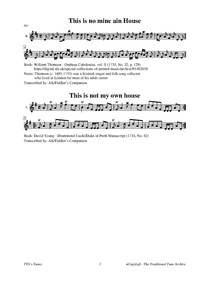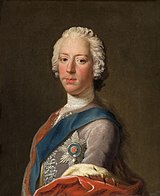Template:Pagina principale/Vetrina: Difference between revisions
No edit summary |
No edit summary |
||
| Line 1: | Line 1: | ||
{{SheetMusic | {{SheetMusic | ||
|f_track= | |f_track=O This Is No My Ain Lassie.mp3 | ||
|f_pdf= | |f_pdf=This is no mine ain House.pdf | ||
|f_artwork= | |f_artwork=Lost_Portrait_of_Charles_Edward_Stuart.jpg | ||
|f_tune_name= | |f_tune_name=This is not My Own House | ||
|f_track_title= | |f_track_title=This is not My Own House | ||
|f_section= | |f_section=X4 | ||
|f_played_by=[https://soundcloud.com/ | |f_played_by=[https://soundcloud.com/gillbowman Gill Bowman] | ||
|f_notes= | |f_notes= Prince Charles Edward Stuart, 1720 - 1788. | ||
|f_caption= | |f_caption=Bonnie Prince Charlie danced to this tune at the house of Lude, near Blair, before the battle of Prestonpans, 1745 | ||
|f_source=[https://soundcloud.com/ | |f_source=[https://soundcloud.com/gillbowman/o-this-is-no-my-ain-lassie Soundcloud] | ||
|f_pix=420 | |f_pix=420 | ||
|f_picpix=200 | |f_picpix=200 | ||
|f_article=[[ | |f_article=[[This is not My Own House | '''This is not My Own House''']] | ||
AKA and see "[[This is No My Ain Lassie (2)]]." The reel is an old one, a version of which appears in the Blaikie MS of 1692 as "[[Abbeyhills Rant]]"<ref>as per James C. Dick, "The Songs of Robert Burns", London, 1903, No. 96.</ref>. Bonnie Prince Charlie danced to this tune at the house of Lude, near Blair, before the battle of Prestonpans, 1745 {he won that one} (Marshall monogram, 1845 Collection, and Winstock 1970). Country dance directions to the tune were recovered from the '''Holmain Manuscript''' from Dumfries-shire (c. 1710-1750). | |||
{ | |||
'' | |||
}} | }} | ||
Revision as of 15:12, 25 November 2023

Played by: Gill Bowman
Source: Soundcloud
Image: Prince Charles Edward Stuart, 1720 - 1788.

AKA and see "This is No My Ain Lassie (2)." The reel is an old one, a version of which appears in the Blaikie MS of 1692 as "Abbeyhills Rant"[1]. Bonnie Prince Charlie danced to this tune at the house of Lude, near Blair, before the battle of Prestonpans, 1745 {he won that one} (Marshall monogram, 1845 Collection, and Winstock 1970). Country dance directions to the tune were recovered from the Holmain Manuscript from Dumfries-shire (c. 1710-1750).
...more at: This is not My Own House - full Score(s) and Annotations
X:4 T:This is not my ain House C:”The Variations by R. Mackintosh” M:C L:1/16 R:Air Q:"Slow" B:Robert Mackintosh - "A Fourth Collection of New Strathspey Reels, also some Famous old Reels" (1804, p. 16) N:Dedicated to the Dutchess [sic] of Manchester N:Robert "Red Rob" Mackintosh (c. 1745-1808) was a Scottish violinist and N:composer active in Edinburgh at the end of the 18th century. Originally from N:Tullymet, near Pitlochry, Perthshire. He moved to London in the last decade N:of his life. Z:AK/Fiddler's Companion K:D V:1 clef=treble name="4." [V:1] A2|FA3 Da3 {g}f4 e3d|(B2cd) (BA)(GF) B3EE3A|FA3Da3 {g}f4 e2d2|B3dAF3 AD3D2|| A2|FA3DA3 FA3B3A|FA3Df3 e2E2E3A|FA3DA3 FA3BB3A|(Bcd2) (cde2) d2D2D2A2| FA3DA3 FA3TBA3|FA3Df3 e2E2E2g2|{fg}a3fg3e f3de3c|{Bc}d3BA3F AD3D2|| A2|FGAF Da3 {g}f4 e3d|(BA)(dc) (BA)(GF) B2E2E2A2|(FGAF) (DFA)a (fefg) (fedc)|BABd BAGF AD3D2|| A2|(FD)(A,D) (FD)(AF) (DA,)(FD) AFdA|DFAd FAdf eEEA/G/|FDA,D A,DFD AFdA fdAF|(BcdB) (cdec) d2(D2 D)(dAG)| (FD)(A,D) (A,D)(FD) (FD)(AF) (dA)(FA)|(DF)(Ad) (FA)(df) e2E2 E(efg)|(.b.a.g.f .a.g.f.e .g.f.e.d .f.e.d.c)|(.e.d.c.B .A.B.d.F) AD3D2|| AG|(A/.A,/.B,/.C/ .D/.E/.F/.G/ .A/.B/.c/.d/.e/.f/.g/.a/) (.g/.f/.g/.a/ .g/.f/.b/.a/ .g/.f/.e/.d/ .f/.e/.d/.c/)|(B/^A/B/c/) (B/c/d/c/) (d/c/B/=A/) (B/A/G/F/) (B/=c/A/B/ G/A/F/G/ E/F/G/E/ A/G/F/E/)| |(A/.A,/.B,/.C/ .D/.E/.F/.G/ .A/.B/.c/.d/.e/.f/.g/.a/) g/f/g/a/ g/f/b/a/ g/f/e/d/ f/e/d/c/|((c/B/)(d/c/)(e/d/)(f/e/) .g/.f/.e/.d/ .f/.e/.d/.c/ .e/.d/.c/.B/ .A/.G/.F/.E/ D)|| AG|F/D/A,/D/ B,/D/C/D/ A,/D/B,/D/ C/D/F/D/ A,/(F/D/)(A/ F/)(d/A/)(f/ d/)(a/f/)d/ A/(f/d/)(A/|F/)d/A/F/ G/A/B/c/ d/c/B/A/ G/F/E/D/ B,/(G/E/)(B/ G/)(e/B/)(g/ e/)(E/G/F/) E/G/F/E/| .D/.A,/.B,/.C/ .C/.E/.F/.G/ .A/.D/.E/.F/ .G/.A/.B/.c/ .d/.A/.B/.c/ .c/.e/.f/.g/ (.a/f/)(d/A/) (f/d/)(A/F/)|(B/c/d/c/) (B/c/d/B/) (c/d/e/d/) (c/d/e/c/) (d/f/e/f/) (d/e/c/d/) (B/.d/.c/.B/ .A/.G/.F/.E/)| D/D/A,/D/ A,/D/B,/D/ A,/D/B,/D/ C/D/F/D/ A,/(F/D/)(A/ F/)(d/A/)(f/ d/)(a/f/)(d/ A/)(f/d/)(A/|F/)(d/A/)F/ D/A/B/c/ .d/.c/.B/.A/ .B/.F/.E/.D/ E(E/G/F/) (E/G/)(B/A/) (G/B/)(e/^d/) (e/f/g/b/)| (.a/.d/.e/.f/ .g/.a/.b/.c'/ .d'/.c'/.b/.a/.b/.f/.e/.d/ e/).b/.a/.g/.f/.e/.d/.c/ d/c/B/A/ B/A/G/F/|(G/B/)(A/c/) (B/d/)(c/e/) (d/f/)(e/g/) (f/a/)(c/e/) (.d/.d/.c/.B/.A/.G/.F/.E/) D||
- ↑ as per James C. Dick, "The Songs of Robert Burns", London, 1903, No. 96.
